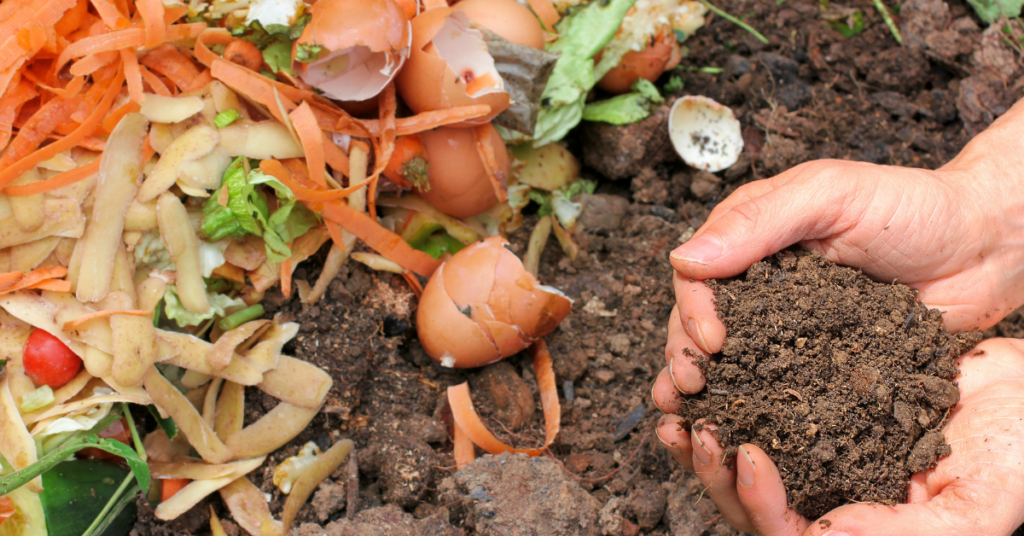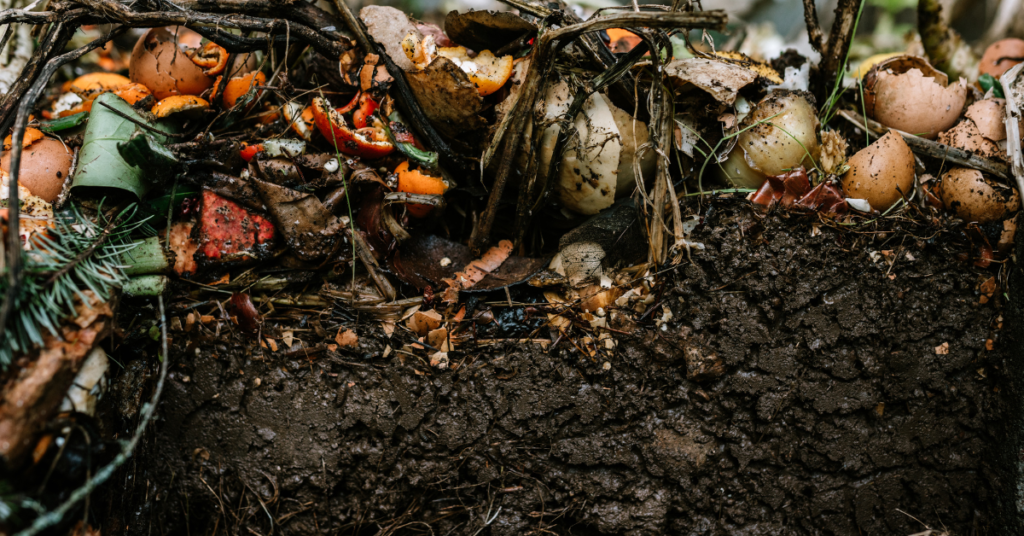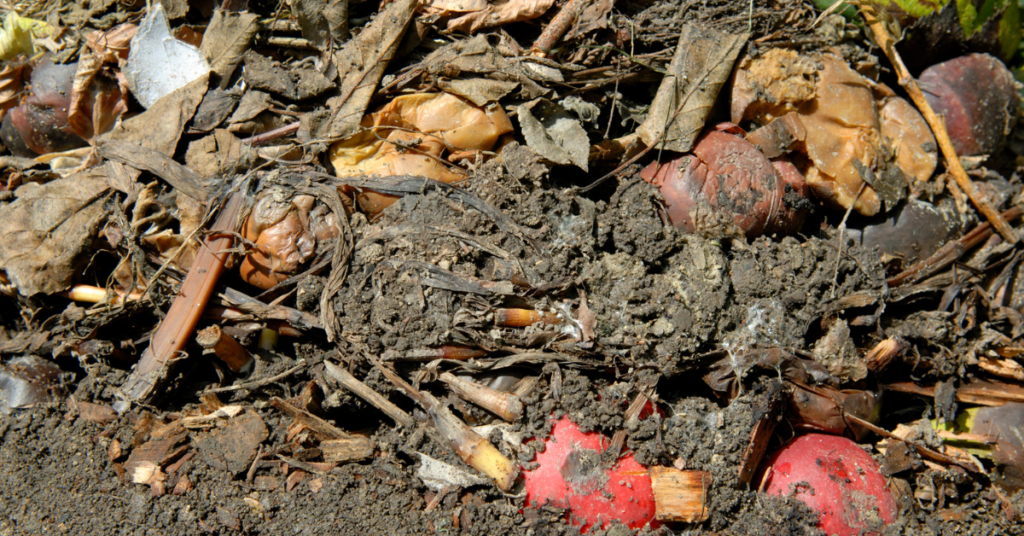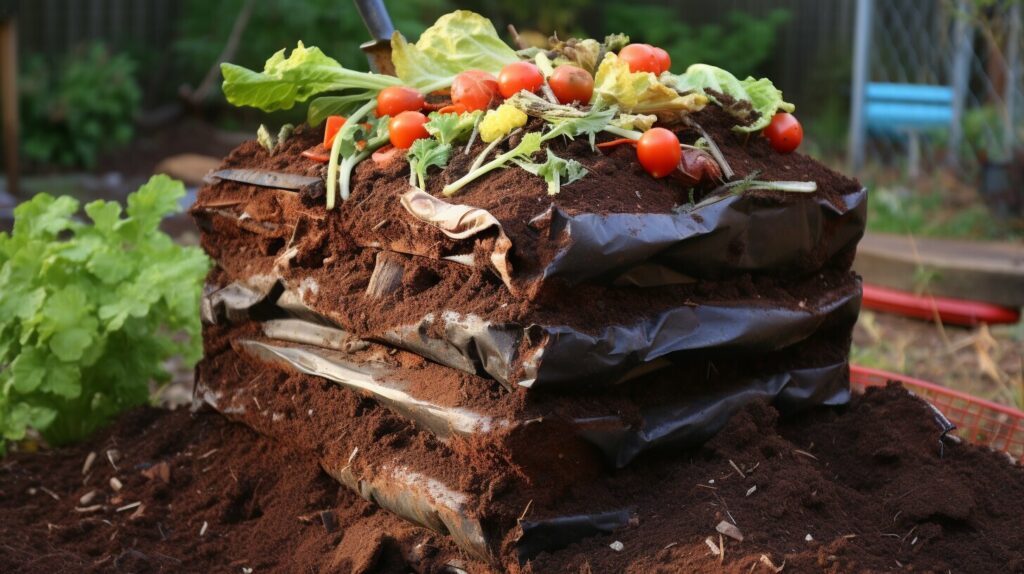Welcome to our comprehensive guide on lasagna composting, a sustainable gardening technique that will help you enrich your soil naturally. Whether you’re new to organic gardening or looking for alternative composting techniques, lasagna composting offers a beginner-friendly and eco-friendly solution. By layering organic materials, you can create nutrient-rich soil that promotes healthy plant growth without the need for synthetic fertilizers.
For more information on the different composting methods read this blog post. Different Types Of Compost To Enrich Your Soil
Sustainable Gardening Benefits:
- Lasagna composting is a sustainable gardening method that involves layering organic materials to enrich soil naturally.
- It eliminates the need for tilling and provides a beginner-friendly alternative to traditional composting techniques.
- Lasagna composting improves soil fertility, retains moisture, suppresses weed growth, and reduces waste by utilizing kitchen scraps and yard waste.
- Building the layers of a lasagna garden is a simple process that requires cardboard or newspaper, green and brown materials, compost, and mulch.
- Maintaining a lasagna garden requires regular watering and minimal turning of layers, providing a continuous source of nutrients for your plants.
The Advantages of Lasagna Composting
Lasagna composting, also known as sheet composting or sheet mulching, offers several advantages to gardeners. Firstly, it improves soil fertility by adding organic matter and nutrients. The layers of organic materials break down over time, releasing nutrients into the soil and promoting healthy plant growth. This natural method of enriching the soil eliminates the need for chemical fertilizers, making it an excellent choice for organic gardening. Lasagna composting also helps retain moisture in the soil, reducing the need for frequent watering. The layers act as a natural mulch, preventing water evaporation and providing a constant supply of moisture to the plants. Additionally, this method suppresses weed growth by smothering existing weeds with layers of cardboard or newspaper, minimizing the need for herbicides. By utilizing kitchen scraps and yard waste, lasagna composting also reduces waste and promotes sustainability.

Lasagna composting is a sustainable practice that improves soil fertility, retains moisture, suppresses weeds, and reduces waste. It is an excellent choice for organic and sustainable gardening.
In summary, the advantages of lasagna composting can be categorized as follows:
- Enhanced Soil Fertility: Lasagna composting adds organic matter and nutrients to the soil, promoting healthy plant growth.
- Moisture Retention: The layers act as a natural mulch, reducing water evaporation and minimizing the need for frequent watering.
- Weed Suppression: By smothering existing weeds, lasagna composting helps suppress weed growth, reducing the need for herbicides.
- Sustainability: Lasagna composting reduces waste by utilizing kitchen scraps and yard waste, making it an environmentally-friendly gardening practice.
By embracing lasagna composting in your garden, you can enjoy the benefits of healthier plants, reduced water usage, and a more sustainable approach to gardening.
| Advantages of Lasagna Composting |
|---|
| Improved soil fertility |
| Moisture retention |
| Weed suppression |
| Sustainability |
Building the Layers of a Lasagna Garden
Building the layers of a lasagna garden is a simple and rewarding process that will set the foundation for a thriving organic garden. Here’s a step-by-step guide to help you create nutrient-rich soil for your plants:
Selecting the Location
Before you start building your lasagna garden, choose a suitable location that receives ample sunlight. This will ensure that your plants have the necessary light for photosynthesis and growth. Additionally, consider the accessibility of the area for watering and maintenance.
Preparing the Ground
To prepare the ground for your lasagna garden, cut the grass short and remove any weeds or debris. While lasagna gardening does not require tilling, you can choose to till the soil lightly if desired. Tilling can help loosen compacted soil and improve water drainage.
Gather the Materials
The success of your lasagna garden relies on the quality and variety of materials you use. Gather the following materials: cardboard or newspaper for weed suppression, green materials like kitchen scraps and grass clippings for nitrogen, brown materials such as dry leaves or shredded newspaper for carbon, compost for added nutrients, and mulch for moisture retention.
Layering the Materials
Start by laying down a thick layer of cardboard or newspaper on the prepared ground. This will smother any existing weeds and prevent them from growing through the lasagna layers. Next, add a layer of green materials, followed by a layer of brown materials. Alternate the layers, ensuring a balanced mix of greens and browns. Add compost between the layers to introduce beneficial microorganisms that aid in the breakdown of the organic materials. Finally, top it off with a layer of mulch to retain moisture and suppress weed growth.
| Layer | Materials |
|---|---|
| 1 | Cardboard or newspaper |
| 2 | Green materials (kitchen scraps, grass clippings) |
| 3 | Brown materials (dry leaves, shredded newspaper) |
| 4 | Compost |
| 5 | Mulch |
Water each layer thoroughly as you add them to ensure proper decomposition. It’s important to maintain a moist environment for the materials to break down effectively.
By following these steps, you’ll be able to build the layers of your lasagna garden and create nutrient-rich soil that will support healthy plant growth. Remember to water regularly and monitor the moisture levels to ensure optimal conditions for decomposition. With time, the layers will break down naturally, providing a continuous source of nutrients for your plants.

Ingredients for a Successful Lasagna Garden
Creating a successful lasagna garden requires a variety of ingredients that work together to create nutrient-rich soil. Here are the key components you’ll need to gather:
- Cardboard or Newspaper: This will serve as the base layer of your lasagna garden, suppressing weed growth and providing a barrier between the soil and organic materials.
- Green Materials: These include kitchen scraps like fruit and vegetable peels, grass clippings, and coffee grounds. They provide nitrogen, an essential element for healthy plant growth.
- Brown Materials: Dry leaves, shredded newspaper, and straw are examples of brown materials that provide carbon, which helps balance the nitrogen from the green materials.
- Compost: Adding compost to your lasagna garden enriches the soil with beneficial microorganisms and additional nutrients.
- Mulch: A final layer of mulch helps retain moisture in the soil, suppress weed growth, and regulate soil temperature.
These ingredients can be sourced from your kitchen, yard, or local garden center. The ratios of green to brown materials may vary depending on availability, but aim for a balanced mix to ensure optimal decomposition and nutrient release.
Table: Ingredients for a Successful Lasagna Garden
| Ingredient | Purpose |
|---|---|
| Cardboard or Newspaper | Suppresses weeds, creates a barrier |
| Green Materials | Provides nitrogen for healthy growth |
| Brown Materials | Provides carbon for balance |
| Compost | Enriches soil with microorganisms and nutrients |
| Mulch | Retains moisture, suppresses weeds, regulates temperature |
By gathering these ingredients and layering them properly, you’ll create a successful lasagna garden that nurtures your plants and promotes sustainable gardening practices.
The Art of Layering in Lasagna Composting
Layering is a crucial aspect of lasagna composting that contributes to its success in organic gardening. It involves strategically adding different materials to create a well-balanced composting environment in your lasagna garden. By following the proper layering technique, you can ensure optimal decomposition and nutrient release, leading to a thriving garden.
The first layer in lasagna composting is the base layer, which serves as weed suppression. This layer, made of cardboard or newspaper, prevents weed growth by blocking sunlight. It also helps to retain moisture in the lower layers, promoting decomposition. Place a thick layer of cardboard or several sheets of newspaper at the bottom of your lasagna garden bed.
Next, alternate layers of green and brown materials to provide the necessary balance of nitrogen and carbon. Green materials, such as kitchen scraps and fresh grass clippings, are rich in nitrogen. Brown materials, like dry leaves or shredded newspaper, contribute carbon to the mix. Aim for a ratio of approximately 1 part green to 2 parts brown materials. This balance encourages the breakdown of organic matter and the release of nutrients into the soil.
Throughout the layering process, it’s beneficial to add compost between the layers. This introduces beneficial microorganisms that aid in the decomposition process and contribute additional nutrients to the soil. Compost acts as a valuable source of organic matter, enriching the soil and promoting plant growth.
Benefits of Layering in Lasagna Composting
The layering technique in lasagna composting offers several benefits. Firstly, it creates a nutrient-rich environment that supports healthy plant growth. The gradual decomposition of organic materials releases essential nutrients into the soil, providing a sustainable source of nourishment for your plants.

In addition, layering helps to retain moisture in the soil, reducing the need for frequent watering. The various layers act as a natural mulch, preventing evaporation and maintaining soil moisture levels. This is particularly beneficial in dry or arid climates where water conservation is essential.
Furthermore, the layers of organic materials smother existing weeds, suppressing their growth and reducing competition for nutrients and sunlight. By effectively preventing weed growth, layering in lasagna composting minimizes the need for herbicides and manual weeding, making it an eco-friendly and low-maintenance gardening technique.
| Benefit | Description |
|---|---|
| Improved Soil Fertility | The layering technique enriches the soil with organic matter and nutrients, providing an ideal growing environment for plants. |
| Moisture Retention | The layers act as a natural mulch, reducing water evaporation from the soil and minimizing the need for frequent watering. |
| Weed Suppression | The layers smother existing weeds, preventing their growth and reducing competition for resources. |
Layering is a key component of lasagna composting that helps create a nutrient-rich, moisture-retentive environment while suppressing weed growth. It’s an effective and sustainable gardening technique that can be easily implemented in your lasagna garden.
Maintaining and Turning a Lasagna Garden
After setting up your lasagna garden, it requires minimal maintenance to keep it thriving. One of the key advantages of this method is that the layers will naturally decompose over time, providing a continuous source of nutrients for your plants. However, there are a few important tasks to keep in mind to ensure the success of your garden.
Watering
Regular watering is essential to maintain the moisture levels in your lasagna garden. Depending on the weather conditions and the needs of your plants, you may need to water once or twice a week. It’s important to keep the soil moist but not waterlogged, as excess moisture can lead to root rot or mold. Watering deeply and thoroughly can encourage deep root growth and promote healthy plants.
Preventing Soil Compaction
Avoid walking on the garden beds to prevent soil compaction. Compacted soil can hinder root growth and make it difficult for plants to access nutrients and water. Instead, create pathways or stepping stones around the garden to provide access without compacting the soil. If you need to reach the center of the bed, use a board or wooden plank to distribute your weight evenly.
No Turning Required
In traditional composting methods, turning the compost pile is necessary to promote decomposition. However, in lasagna gardening, turning the layers is not required. The materials will naturally break down over time, and turning them may disrupt the decomposition process. However, if you notice any areas that are not decomposing properly, you can gently mix the layers to promote decomposition.
Summary
Maintaining a lasagna garden is relatively easy and requires minimal effort. Regular watering, preventing soil compaction, and avoiding unnecessary turning of the layers are the key tasks to keep in mind. By following these maintenance practices, you can enjoy the benefits of a thriving and sustainable garden.
| Maintenance Tasks | Recommendations |
|---|---|
| Watering | Water deeply and thoroughly once or twice a week, depending on weather conditions. |
| Preventing Soil Compaction | Avoid walking on the beds; use pathways or stepping stones to access the garden. |
| No Turning Required | Do not turn the layers; let them naturally decompose over time. |
Benefits of Lasagna Composting for Your Garden
Lasagna composting offers numerous benefits for your garden, making it an excellent choice for organic and sustainable gardening practices. By implementing this method, you can improve the fertility and structure of your soil, resulting in healthier plants and increased yields. The layers of organic materials act as a natural mulch, helping to retain moisture in the soil and reduce the frequency of watering. This not only saves time and resources but also promotes water conservation.
In addition to its soil-enhancing properties, lasagna composting also provides natural pest control. The layers of organic materials attract beneficial insects that prey on garden pests, reducing the need for chemical pesticides. By creating a diverse and balanced ecosystem in your garden, you can maintain a healthy balance between predators and pests, ensuring the well-being of your plants.
“Lasagna composting offers numerous benefits for your garden, including improved soil fertility, natural moisture retention, reduced weed growth, and natural pest control.”
Moreover, lasagna composting is a sustainable gardening practice that reduces waste. By utilizing kitchen scraps and yard waste as composting materials, you can divert organic matter from landfills and contribute to the circularity of nutrients. This not only helps the environment but also reduces the need for synthetic fertilizers, minimizing the potential for water pollution and soil degradation.
Table: Benefits of Lasagna Composting for Your Garden
| Benefit | Description |
|---|---|
| Improved Soil Fertility | The layering of organic materials enriches the soil with nutrients, promoting healthy plant growth. |
| Natural Moisture Retention | Lasagna composting acts as a natural mulch, helping the soil retain moisture and reducing the need for frequent watering. |
| Reduced Weed Growth | The layers of organic materials smother existing weeds, decreasing their growth and minimizing the need for herbicides. |
| Natural Pest Control | The layers attract beneficial insects that prey on garden pests, reducing the need for chemical pesticides. |
| Sustainable Practice | Lasagna composting reduces waste by utilizing kitchen scraps and yard waste, contributing to the circularity of nutrients and minimizing reliance on synthetic fertilizers. |
Overall, lasagna composting offers a range of benefits for your garden, from soil improvement to water conservation and natural pest control. By implementing this sustainable gardening practice, you can create a thriving and environmentally-friendly garden that will provide you with bountiful harvests while minimizing your ecological footprint.
When to Start a Lasagna Garden
Lasagna gardening can be started at any time of the year, depending on your goals and the availability of materials. If you want to start a new garden bed in the spring, it’s best to begin the lasagna composting process in the fall or winter. This gives the layers enough time to decompose and create a nutrient-rich soil for planting. However, if you’re looking for a quicker solution, you can start a lasagna garden in the spring and plant immediately after building the layers. The key is to ensure that there are enough organic materials and moisture to promote decomposition.
Starting a lasagna garden in the fall or winter has its advantages. By preparing the bed ahead of time, the layers will have ample time to break down and create a healthy environment for your plants. This method also utilizes the colder months to naturally decompose the organic materials. Come springtime, you’ll have a fertile garden bed ready for planting.
On the other hand, if you’re eager to get started in the spring, you can build the layers directly and plant right away. This approach allows you to have a garden bed in a relatively short time frame. However, keep in mind that the layers may not have fully decomposed yet, and it may take some time for the organic material to break down and release nutrients into the soil. Regular watering and adding compost can help accelerate the decomposition process.
Common Issues in Lasagna Composting
While lasagna composting is a relatively simple and effective method for enriching your garden soil, there are some common issues that gardeners may encounter. By understanding and troubleshooting these issues, you can ensure that your lasagna composting process is successful and yields healthy, nutrient-rich soil for your plants.
Possible Issue: Slow Decomposition
If you notice that the layers in your lasagna bed are not decomposing as quickly as expected, this could be due to insufficient moisture or incorrect ratios of green to brown materials. The layers need to be adequately watered to promote decomposition, so be sure to water each layer thoroughly as you add them. Additionally, check the ratios of green (nitrogen-rich) to brown (carbon-rich) materials in your layers. A balanced mix of greens and browns is essential for optimal decomposition and nutrient release.
Possible Issue: Weed Growth
If you’re experiencing weed growth in your lasagna garden, it could be due to a few reasons. Firstly, ensure that the initial weed suppression layer made from cardboard or newspaper is thick enough to effectively smother existing weeds. Also, be cautious when adding compost, as it may contain seeds or roots of weeds. To prevent weed growth, consider adding a thicker layer of cardboard or newspaper between the compost layers to act as a stronger barrier against weed germination.
Possible Issue: Unpleasant Odor
An unpleasant odor coming from your lasagna bed could indicate that the materials are not decomposing properly. This could be due to imbalanced ratios of green to brown materials or excessive moisture. Check the moisture levels in your garden bed and adjust if necessary. It’s also important to maintain a balanced mix of greens and browns to create an ideal environment for decomposition. If the odor persists, you may need to revisit the layering process and ensure that the materials are layered correctly.
| Possible Issue | Cause | Solution |
|---|---|---|
| Slow Decomposition | Insufficient moisture or incorrect ratios of green to brown materials | Ensure adequate moisture and balanced mix of greens and browns |
| Weed Growth | Inadequate weed suppression layer or introduction of weed seeds through compost | Add a thicker weed suppression layer and be cautious with compost materials |
| Unpleasant Odor | Imbalanced ratios of green to brown materials or excessive moisture | Adjust moisture levels and ensure balanced mix of greens and browns |
By addressing these common issues in lasagna composting, you can troubleshoot and overcome challenges to create nutrient-rich soil for your garden. Remember to regularly monitor and maintain moisture levels, balance the ratios of greens and browns, and properly suppress weed growth. With a little troubleshooting, you can enjoy the benefits of lasagna composting and cultivate a thriving organic garden.
Variations and Approaches to Lasagna Composting
Lasagna composting, also known as sheet composting or sheet mulching, offers gardeners a flexible and adaptable method for enriching their soil. While the basic principles remain the same, there are various variations and innovative approaches that can be explored to customize your lasagna composting experience. These variations allow you to tailor the method to suit your gardening goals and plant preferences.
Lasagna Mulching
One popular variation is lasagna mulching, which involves applying lasagna layers directly on top of existing soil or in established garden beds. This approach can be a time-saving method for revitalizing tired or compacted soils, as the organic layers gradually break down and improve soil fertility and structure. Lasagna mulching is particularly beneficial for suppressing weeds, retaining moisture, and promoting healthy plant growth. It can be a great option for gardeners looking to rejuvenate their gardens without extensive digging or tilling.
Targeted Ingredient Additions
Another innovative approach to lasagna composting is incorporating specific ingredients based on the needs of your plants. For example, you can add coffee grounds for acid-loving plants or seaweed for plants that require additional trace minerals. These targeted ingredient additions can enhance the nutrient profile of your lasagna layers and provide specialized benefits for specific plant types. By experimenting with different ingredients, you can create a customized lasagna composting method that caters to the unique requirements of your garden.
Integrating Biochar
Biochar, a form of charcoal produced from organic waste, can be a valuable addition to your lasagna composting layers. By integrating biochar into the lasagna layers, you can enhance nutrient retention, improve soil structure, and promote the growth of beneficial microorganisms. Biochar acts as a sponge, holding onto nutrients and water, making them more readily available to plant roots. This addition can further enhance the overall fertility and health of your garden soil, resulting in robust and thriving plants.
Remember, lasagna composting is a versatile method that can be customized to suit your preferences and specific gardening requirements. Whether you choose to experiment with lasagna mulching, targeted ingredient additions, or integrating biochar, the key is to enjoy the process and observe the positive impact it has on your garden. Through these variations and innovative approaches, you can create a more sustainable and productive garden while embracing the principles of organic gardening.
If you would like to learn other methods of composting read the below articles:
- Pit Composting: Easy and Effective Eco-Friendly Waste Disposal
- Unlocking the Benefits of Bokashi Composting
Benefits of Lasagna Composting in Your Garden
Lasagna composting, also known as sheet composting or sheet mulching, offers a range of benefits for your garden. By following a few simple tips, you can maximize these benefits and create a thriving, sustainable garden. Here are some key strategies to consider:
- Ensure Adequate Moisture: Proper moisture is essential for decomposition and nutrient release in your lasagna garden. Regularly water the layers to keep them moist, but be careful not to oversaturate the bed, as this can lead to waterlogging and hinder plant growth. Monitoring the moisture levels and adjusting watering accordingly is key.
- Add Organic Materials: To maintain the height and nutrient content of the layers, periodically add organic materials to your lasagna garden. These can include kitchen scraps, yard waste, or compost. By replenishing the organic matter, you ensure a continuous supply of nutrients for your plants.
- Patience is Key: Allow the layers to fully decompose before planting. This may take several months, but it ensures that the nutrients are readily available to your plants and promotes healthy growth. Be patient and resist the urge to rush the process for optimal results.
By implementing these strategies, you can make the most of lasagna composting in your garden. This sustainable gardening technique not only enriches your soil but also reduces the need for chemical fertilizers and promotes a healthier, more environmentally-friendly garden. Embrace the benefits of lasagna composting and enjoy the rewards of lush plants and bountiful harvests.
Conclusion
Lasagna composting is a sustainable and effective method for enriching your garden soil and promoting organic gardening practices. By layering organic materials, such as kitchen scraps, grass clippings, and leaves, you can create nutrient-rich soil that nourishes your plants and reduces the need for chemical fertilizers. This composting technique is beginner-friendly and can be implemented in various gardening settings, making it accessible to gardeners of all levels.
One of the key benefits of lasagna composting is its contribution to sustainable gardening. With this method, you can reduce waste by utilizing kitchen scraps and yard waste, transforming them into valuable resources for your garden. Lasagna composting also minimizes the need for tilling, preserving the soil structure and preventing erosion.
Through the layering process, lasagna composting creates a balanced environment that supports optimal decomposition and nutrient release. The layers of organic materials break down over time, providing a continuous source of nutrients to your plants. This results in healthier and more productive gardens, with improved soil fertility and structure.
Embrace the innovative techniques of lasagna composting and experience the rewards of a thriving and sustainable garden. By implementing this method, we can contribute to a greener future and reduce our impact on the environment. Let’s nurture our gardens and nurture our planet through the power of lasagna composting.
FAQ
What is lasagna composting?
Lasagna composting, also known as sheet composting or sheet mulching, is a sustainable gardening method that involves layering organic materials to create nutrient-rich soil.
What are the advantages of lasagna composting?
Lasagna composting improves soil fertility, retains moisture in the soil, suppresses weed growth, and reduces waste by utilizing kitchen scraps and yard waste.
How do I build the layers of a lasagna garden?
Start by laying down a base layer of cardboard or newspaper, then alternate layers of green and brown materials, adding compost as you go. Finally, top it off with a layer of mulch.
What ingredients do I need for a successful lasagna garden?
The key materials include cardboard or newspaper, green materials like kitchen scraps and grass clippings, brown materials such as dry leaves or shredded newspaper, compost, and mulch.
What is the importance of layering in lasagna composting?
Layering is important to create a well-balanced composting environment. The layers should be added in a specific order, starting with a base layer of cardboard or newspaper, followed by alternating layers of green and brown materials.
How do I maintain and turn a lasagna garden?
Lasagna gardens require minimal maintenance. Keep the garden bed moist by watering regularly, avoid walking on the beds to prevent soil compaction, and gently mix the layers if necessary.
What are the benefits of lasagna composting for my garden?
Lasagna composting improves soil fertility and structure, helps retain moisture in the soil, suppresses weed growth, and promotes natural pest control.
When is the best time to start a lasagna garden?
Lasagna gardening can be started at any time of the year, depending on your goals and the availability of materials.
What are some common issues in lasagna composting and how do I troubleshoot them?
Common issues include slow decomposition, weed growth, and unpleasant odors. To address these issues, ensure adequate moisture, balanced green to brown ratios, and a thicker weed suppression layer.
What are some variations and innovative approaches to lasagna composting?
Variations include lasagna mulching and using specific ingredients like coffee grounds or seaweed. Gardeners can experiment with different techniques to suit their specific gardening goals and plant preferences.
How can I maximize the benefits of lasagna composting in my garden?
Maximize benefits by adequately watering the layers, monitoring moisture levels, regularly adding organic materials, and allowing the layers to fully decompose before planting.



